Sustainable Mobility Matters—Summer 2022
This quarterly newsletter highlights recent projects, partnerships, and publications related to NREL's sustainable mobility research.
Subscribe to receive this newsletter via email.

Enabling the Marketplace To Keep Pace With Technological Innovation for a Better Planet
It seems that with every transformational technology, we revisit the reality of facing the same challenges: Its benefits are clear, but it will take significant time and financial commitments to ensure the market can support its affordable, efficient, sustainable results.
Now, as our timeline for effective climate action shrinks, we see the reality again in bold type. We must ramp up production of clean transportation technologies even as we work to build markets, supply chains, and industry capacities capable of supporting them.
Here at the National Renewable Energy Laboratory (NREL), we understand the gravity of this juncture. In many ways, our success in securing ever-bolder climate pledges depends on a calculated strategy for decarbonizing the transportation sector.
While undoubtedly a complex challenge, NREL is taking action to reshape existing mobility solutions that will result in a more resilient climate future, including:
- Lending supply chain analysis expertise to our country’s leaders in the U.S. Department of Energy (DOE) in identifying risks and opportunities in the energy sector supply chain
- Developing and managing DOE's Battery Policies and Incentives database to inform the production of electric vehicle (EV) batteries and development of a secure domestic lithium-ion (Li-ion) battery supply chain
- Supporting the manufacturing of on-, off-, and non-road vehicle components while conducting the research imperative to building better materials and creating a circular economy for vehicle parts
- Researching promising technologies with the goal of developing new ways to generate, store, and use energy
- Administering DOE’s Lithium-Ion Battery Recycling Prize to further the development of a supply chain that addresses the collection, separating and sorting, safe storage and transportation, and reverse logistics of recycling these batteries.
Sure, the challenges ahead are no secret. Surging demand for EVs—and their low energy costs—are testing the resilience of supply chains for batteries and semiconductor chips. Sustainable aviation fuel producers continue to navigate a host of complex—and often competing—demands to guarantee systems are technically viable, cost-effective, low-carbon, and supported by robust supply chains. Startups are working with agencies, utilities, and communities to rapidly expand our nation's EV charging network.
But the data we already have glimmer with possibility, too. We have the tools we need to make bold decisions, especially when it's most imperative. Are we willing to wield them to build a cleaner, more equitable world?
Drive on,
Chris Gearhart
Director, NREL's Center for Integrated Mobility Sciences

Connecting the Country: Assessing the Benefits of Quick, Electrified Flights From Local Airports
Although more than 5,000 airports dot the United States, just 30 service around 70% of all domestic flights. Overlooked, underused regional and local airports offer the opportunity to improve rural and urban connectivity and may soon service more trips using electric aircraft, which have a competitive edge for shorter flights. In partnership with NASA, NREL is modeling scenarios that could play out with electrified and regional air transit. The project includes evaluating how smaller airports could supply clean power to both the aircraft and the region.
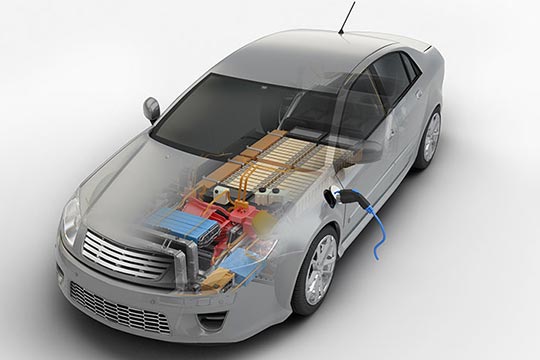
Battery Policies and Incentives Database Contributes to U.S. Efforts To Build a Secure EV Battery Supply Chain
The new Battery Policies and Incentives database, developed and managed by NREL, is advancing the adoption of zero-emission vehicles in the United States by addressing the ongoing need for Li-ion batteries in EVs and stationary storage. The database allows users to search for policies and financial incentives by jurisdiction, battery chemistry, federal agency, status, and type to inform the production of EV batteries and the development of a secure domestic battery supply chain and circular economy for energy materials.

Preparing for New York's Shift to Cleaner, Electric Cars for Ride-Hail Use
A study designed to ensure New York City's EV charging network and local utility can meet the eventual demands of more than 100,000 electric cars for ride-hail use revealed economic and operational insights valuable to transportation network company, utility, and charging operations. Researchers fed real-world data streams—including trip data, driver shift schedules, overnight charging access rates, and even weather—into the Highly Integrated Vehicle Ecosystem simulation framework to model ride-hail charging demand in space and time to inform the development of effective charging networks.
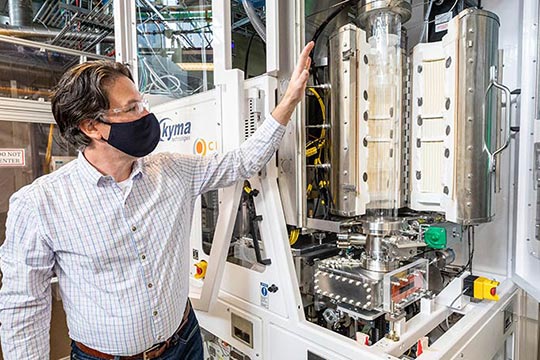
ARPA-E Funding Drives Innovation, Industry Partnerships at NREL
Power electronics and electric machines researchers are involved in no less than seven Advanced Research Projects Agency–Energy (ARPA-E) projects at NREL. These projects range from electrifying aviation (in collaboration with General Electric) to exploring the limits of cooling for extreme heat-flux applications (in collaboration with Stanford University) and developing power electronics for fusion applications (in collaboration with Princeton Fusion Systems). Each of these projects helps foster early-stage collaboration in power electronics, electric machines, and thermal management.
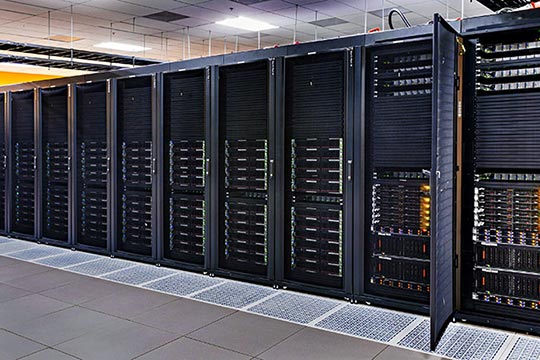
No Time, No Chips: No Problem for NREL
A recent Consumer Reports survey cited new EV costs and limited access to charging stations as the biggest roadblocks to public adoption of EVs. NREL's high-performance computing (HPC) capabilities allow computational science experts to transform data into models and simulations to ultimately build affordable, accessible, and equitable transportation solutions. Despite pandemic-induced global supply shortages, NREL's newest cutting-edge HPC system, Swift, is ready to provide solutions to the country's clean transportation obstacles.
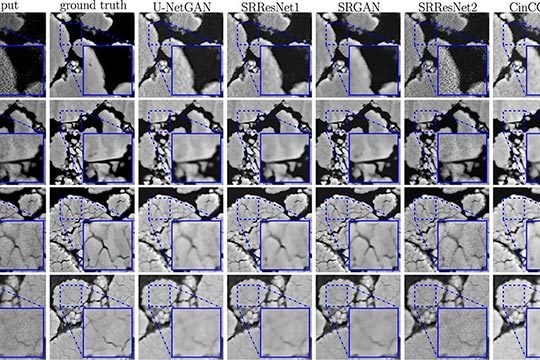
Imaging Capabilities Offer New Opportunities in Energy Materials Research
NREL is at the forefront of cutting-edge research using X-ray diagnostics and advanced machine-learning techniques to examine the composition and architecture of energy materials, such as batteries. New, expanded nanoscale imaging capabilities at the laboratory may help unlock critical information about the performance of energy storage systems. Recent publications emphasize the benefits of nano- and microscale X-ray tomography combined with artificial intelligence to inform future synthesis and manufacturing techniques for next-generation battery materials.
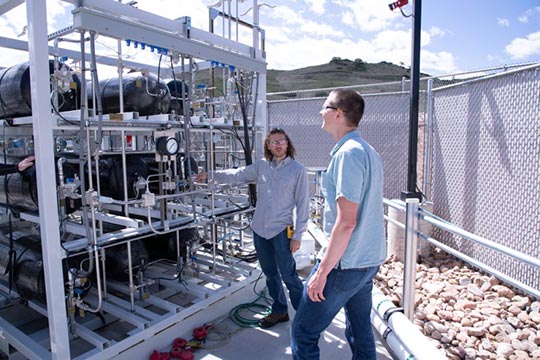
Researchers Demonstrate High-Flow-Rate Hydrogen Fueling for Heavy-Duty Applications
For well over a decade, NREL has supported cutting-edge research and development on hydrogen fueling for light-duty fuel cell EVs, but heavy-duty trucks and vehicles are an undertaking of an entirely different scale. As part of the Innovating High Throughput Hydrogen Stations project, NREL researchers recently demonstrated hydrogen fueling with an average mass flow rate of 14 kg/min (21-kg/min peak) with a 40.3-kg fill into a bank of eight hydrogen storage tanks—similar to those used by heavy-duty vehicles—in 2.87 min.
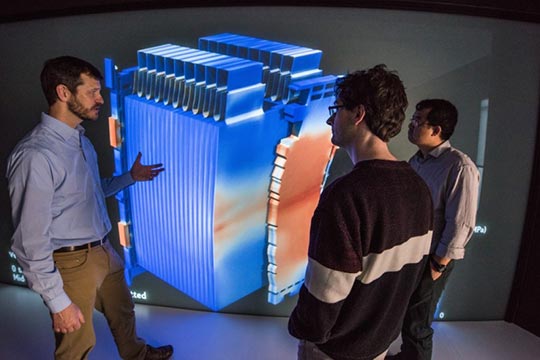
Laboratory Partnerships Bolster Battery Recycling Prize Solutions
Innovation happens when the right resources, people, and passion come together to address a challenge. The Lithium-Ion Battery Recycling Prize unites these elements to build a supply chain that addresses the collection, separating and sorting, safe storage and transportation, and reverse logistics of recycling Li-ion batteries. DOE recently announced four winners of Phase III of the prize: Li Industries of Blacksburg, Virginia; Renewance of Chicago, Illinois; Smartville of San Diego, California; and Titan Advanced Energy Solutions of Salem, Massachusetts.
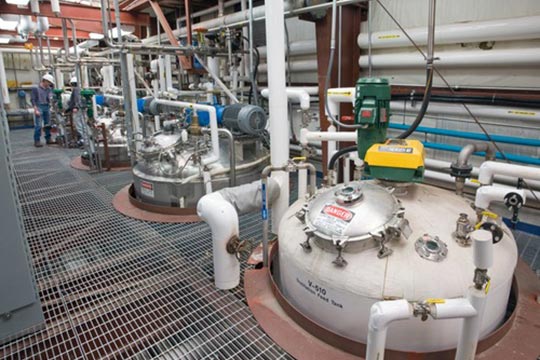
Sustainable Aviation Fuel Project Earns Government–Industry Boost
A government–industry partnership based at NREL will turn agricultural waste of little value—corn stover—into profitable, environmentally friendly fuels. A planned pilot plant project called SAFFiRE, short for Sustainable Aviation Fuel From [i] Renewable Ethanol, could be positioned to use infrastructure at more than 200 existing ethanol plants and equipment already found on farms across the nation. Analysis suggests the resulting sustainable aviation fuel could be less expensive than petroleum-based jet fuel and could reduce carbon intensity by up to 84%.
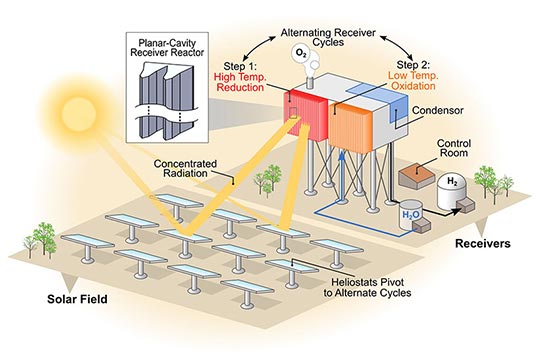
Scientists Advance Renewable Hydrogen Production Method
Perovskite materials may hold the key to generating affordable and renewable hydrogen through solar thermochemical processes. Direct solar thermochemical hydrogen (STCH) production by water splitting can utilize the full spectrum of solar radiation and potentially achieve high solar energy conversion efficiencies. New research developed an STCH platform to assess techno-economic benefits and bridge a gap in the path to STCH scale-up. The analysis of STCH operational boundaries and conceptualized receiver design will facilitate research to identify the best materials for the STCH process more comprehensively.
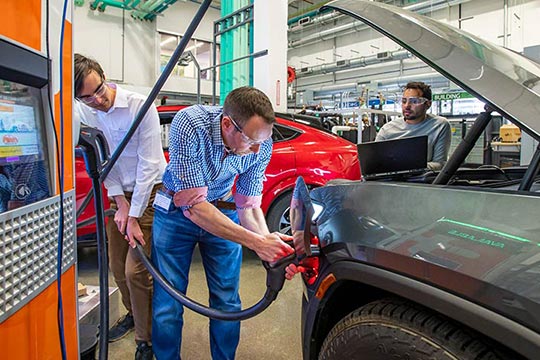
EV Manufacturers Mobilize Behind Charging Cybersecurity at NREL
As more EVs enter the market and connect to the electrical system, cybersecurity is drawing increased interest. In partnership with SAE International and industry, NREL is evaluating the application of the public key infrastructure encryption method to ensure digital trust between vehicles and charging stations. NREL's role has been to assess the cybersecurity of electrified transportation systems under real operating conditions to ensure that systems are robust enough to correctly capture and identify accurate and faulty behaviors. This collaboration will help strengthen the overall security in the connection between the mobility and energy industries.
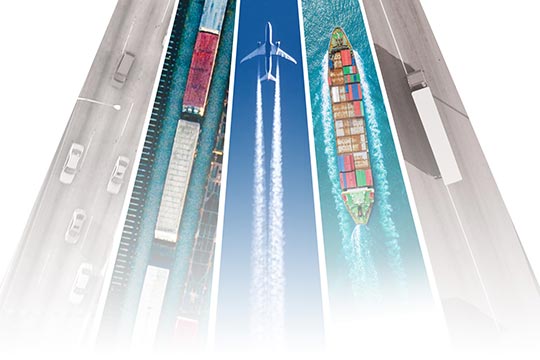
Co-Optima Discoveries Could Help Curtail Climate Impacts Without Significant Infrastructure, System Changes
DOE's Co-Optimization of Fuels & Engines (Co-Optima) initiative recently wrapped up 6 years of fuel and engine research after identifying domestically sourced, bio-based fuel components that can produce 60% fewer greenhouse gas emissions than petroleum-based vehicle fuels and eliminate 99% of harmful freight truck criteria pollutants. Researchers from NREL collaborated with partners from other national labs, universities, and industry to provide the scientific knowledge, data, and tools needed to decide which new engine and bio-based fuel combinations could rapidly cut emissions and reduce dependence on petroleum. Discoveries by the team, detailed in a recently published DOE Co-Optima report, have the potential to slow global warming without requiring significant changes to infrastructure, engine, or vehicle fuel system designs.
Get To Know Our Team: John Kisacikoglu

A conversation with NREL's John Kisacikoglu, manager of the electric vehicle grid integration (EVGI) team.
What is your primary research focus at NREL?
The EVGI research domain is complex and involves multiple disciplines, such as signal processing (machine learning), power systems engineering (transmission to distribution engineering), communication, networking science, power electronics, and control systems theory. My work spans a spectrum of research and engineering arenas, with a focus on mobility and power modeling, control systems development and simulation, hardware design and evaluation, and field demonstration. The team lead models EV power and energy demands from the grid in a spatiotemporal way while developing scalable control solutions ranging from low-power residential charging to megawatt-level high-power charging. I am especially interested in working with utility companies to develop practical, real-world solutions.
In your field of research, what one mobility challenge do we need to prioritize in the next 5 years?
We must develop scalable solutions to effectively power our transportation mobility needs without relying heavily on fossil fuels. Enabling more EV charging to effectively "fuel" electrified transportation without compromising the mobility needs of the public is challenging, and that's what we will target in the coming years.
What sparked your interest in researching sustainable mobility?
As an undergraduate student, I learned early that conventional fuels are not the only solution to our energy needs. Understanding that the principles of electrical engineering can unlock the potential of various alternative energy storage technologies was so motivating for me. I wanted to find novel solutions that utilize electricity to move people and goods around in an efficient way. I researched fuel cells, ultracapacitors, and batteries, and learned more about the operation of the bulk power system. Today, the intersection of transportation and the power grid is my favorite research domain.
Why does sustainable mobility matter?
At the heart of sustainable mobility is the ability to meet people's mobility needs in a clean, safe, efficient, and cost-effective way with minimum impact on the environment. If we want our next generations to live in a world with a minimum carbon footprint, we need to develop solutions that are sustainable for mobility as well as our other daily energy needs. I am looking forward to seeing the next generations make great strides in advancing clean, sustainable energy technologies that meet the changing needs of society.
Must Reads
Thermal Management Strategy Changes the Game for Power Electronics
Managing heat in automotive power electronics can be challenging—and even more so with the ambitious power density targets set by industry and federal agencies. NREL researchers are tackling this issue with a game-changing dielectric fluid cooling concept, which combines a low-thermal-resistance package with a high-performance convective cooling strategy. Learn more about the concept, as well as the modeling and experimental approaches used to validate it, in an issue of IEEE Transactions on Power Electronics.
Next-Generation Traffic Control Boosts Safety for Connected and Automated Vehicles
Connected and automated vehicle technology can fundamentally change the future of transportation, but it requires intelligent infrastructure to safely coordinate the movement of all road users. Read the NREL conference paper about this proposed "infrastructure-based cooperative perception," presented at the ASCE International Conference on Transportation & Development.
Battery Aging Proves Key To Understanding the Effects of Extreme Fast Charging
Extreme fast charging (15 minutes or less) offers an opportunity for widespread EV adoption, but understanding its effects on battery components is critical. In collaboration with Idaho National Laboratory, Argonne National Laboratory, and the Massachusetts Institute of Technology, NREL researchers mapped the key aging mechanisms for high-nickel cathodes, detailing the results in a recent article in Advanced Energy Materials.
Did You Know?
Tune in to recent episodes of the NREL-produced DOE Clean Cities On the Go podcast for the most up-to-date information on alternative fuels, advanced vehicles, and emerging transportation technologies that are transforming mobility as we know it. Listen to the latest:
- Sustainable Aviation Fuel Today: Researchers discuss sustainable aviation fuel as a near-term option to help decarbonize the aviation industry, including how it is produced and distributed and who is currently using it.
- EV Charging Rapidly on the Rise in Oklahoma: EV deployment experts share insights from the ChargeOK program, which used VW settlement funds to invest $3.1 million in EV charging infrastructure, resulting in 90 new DC fast and dual-port Level 2 stations.
In the News
Trying To Electrify Your Home, Add Solar Panels, or Buy an E-Bike? Denver Wants To
Help Pay for It
Denverite cites the NREL-developed OpenPATH tool, a human travel behavior mobile app
The city of Denver, Colorado, recently launched a rebate program to help residents purchase e-bikes, solar panels, cold-climate heat pumps, and other products to ditch fossil fuels. The program aims to advance environmental equity by removing cost barriers and drive a market for a clean energy transition.
Electrification of Cars and Trucks Likely Won't Disrupt the Grid
Physics Today interviews Matteo Muratori
Although there will be an increase in electricity demand as the U.S. transportation system transforms to electric, an NREL transportation electrification expert says there will not be a tipping point that will overwhelm the grid. Because the grid evolves daily as new load is added, the increase is anticipated to be gradual enough to provide plenty of time to adapt.
Electric Planes Take Off
Scientific American interviews Jesse Bennett
There are currently around 170 projects worldwide focused on developing electric planes, ranging from small to larger aircraft for training pilots, carrying cargo, and even ferrying regional passengers. The first 50- to 70-seat electric aircraft are expected to appear in 2028, signaling large growth in the market.
I Test-Drove the All-Electric Hummer. Can It Win Over America's EV Skeptics?
The Guardian interviews Chris Gearhart
The new all-electric Hummer is a demonstration for followers of supersized car culture that EVs no longer have to look like a Prius to be green. The functionalities of power, size, and sensibilities can help convert even the staunchest adversaries of EVs.
Share

